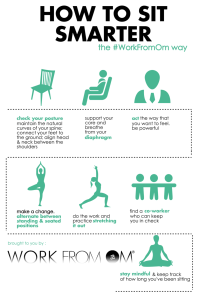This last week has been a blur of airports and cities, cars, buses, metros, etc. Not to be misunderstood, I do sincerely love to travel, but there is no denying that it can be an incredibly grueling, exhausting process on both the physical and mental bodies. The hours spent sitting on planes, trains and in cars alone are enough to cause some damage that even the busiest tourist or traveling business person cannot simply walk off.
You may have heard that sitting is the new smoking, or you may have taken notice of the recent surge in demand for standing desks in progressive offices across the country, but the unfortunate truth is that many of us do not yet have access to these desks, or spend much of our work lives traveling, and cannot avoid the act of sitting entirely.
With this unavoidable health risk facing us as we work and travel, how can we limit the repercussions of a highly sedentary lifestyle? I’ve copied some of the best nuggets of advice that I’ve collected in the above infographic, explained in more detail below.
- Check your posture. One of the simplest ways to help improve your time in a seat is to be conscious of your posture and alignment while doing so. It can be helpful to check in with your feet, making sure that they are firmly connected to the ground. Concentrate on distributing the weight evenly in your sitting bones, your legs and the corners of your feet, and avoiding any leg or ankle crossing to allow for healthy blood flow through the legs and evade any chance of swelling in the lower extremities. When adjusting your upper body, try to maintain the natural curve of your spine, meaning that it is ok to feel some extension in your lower spine, and some natural rounding in your middle to upper back. Concentrate on melting your shoulder blades down your back, and allowing your head to settle into a place of support and comfort between your shoulders.
- Use your diaphragm. There is a certain kind of magic that a deep belly breath can exert over the body. Opting to take those full, deep breaths (as opposed to shallow, chest breaths), allows you to activate the diaphragm which can, in turn, affect the way you sit. Because the diaphragm is a postural muscle that attaches to your lower spine, activating it more consciously while seated helps to avoid imbalances caused by shallow breathing and a partially active or inactive diaphragm.
- Act. Act the way that you want to feel. Act powerful. Act like you care about your body! If you don’t like the way you feet in your seat, change it. Notice what’s uncomfortable, and shift it. Notice where the weight is imbalanced, and balance it. Notice if you need to get up and go for a short walk outside, and allow yourself that moment. It doesn’t matter what kind of action you take, as long as you do act in response to what you are feeling. The worst thing that you can do for your body is to ignore the signals it is giving you and continue to work through them.
- Make a change. Similar to #3 above, make sure to change up your position throughout the day, throughout your flight, or wherever you find yourself stuck for an extended period of time. Ideally, you could shift between sitting and standing every 15 to 20 minutes, but for those of us who may be found stuck in meetings or flights that run much longer than that, do the best that you can to get up and down when you can.
- Stretch it out. Cue workplace yoga sessions. When your muscles are healthy, it’s much easier to support a good posture. While yoga asanas can be used to heal a variety of mind and body ailments, focusing on specific postures that unlock tension in hips, spine and shoulders / neck are some of the best antidotes to a sedentary lifestyle.
- Enlist a co-worker. Having a friend or colleague help you to monitor your posture, or how long you’ve been sitting during a given day can be immensely helpful. It is also nice to have someone to stretch your legs with if they’re game for a walk, or to slow down and take some deep, diaphragmatic breaths with.
- Stay mindful. One of the most dangerous parts about living a sedentary lifestyle is the opportunity to be thoroughly disconnected and disenaged during most of those seated moments. It may be helpful to set an alarm to go off every hour just as a reminder to adjust your seat, check in with your posture, or just bring your attention back into your seated body and act based on what you feel you need in that moment. Setting a small trigger to bring your attention back to your body multiple times per day, over time, may actually help you to start becoming more aware of your body and its needs in the moments between the alarm triggers as well. Wouldn’t that be nice?
From: Work from Om

